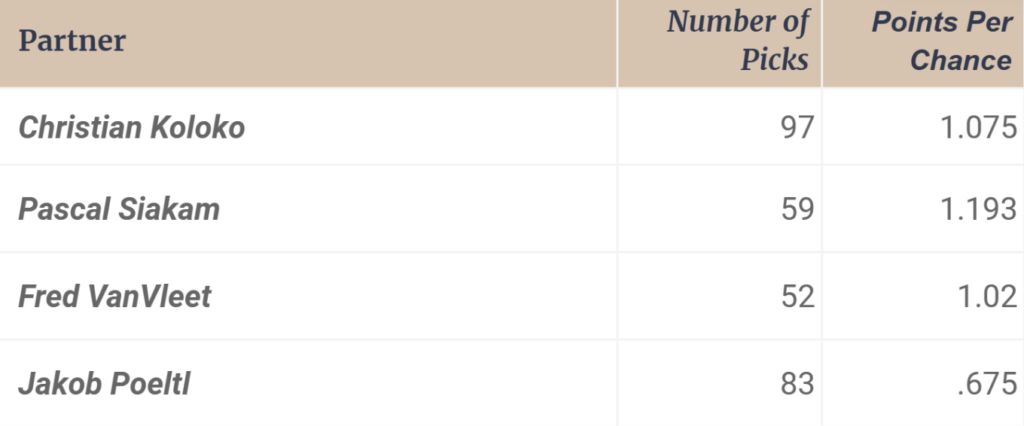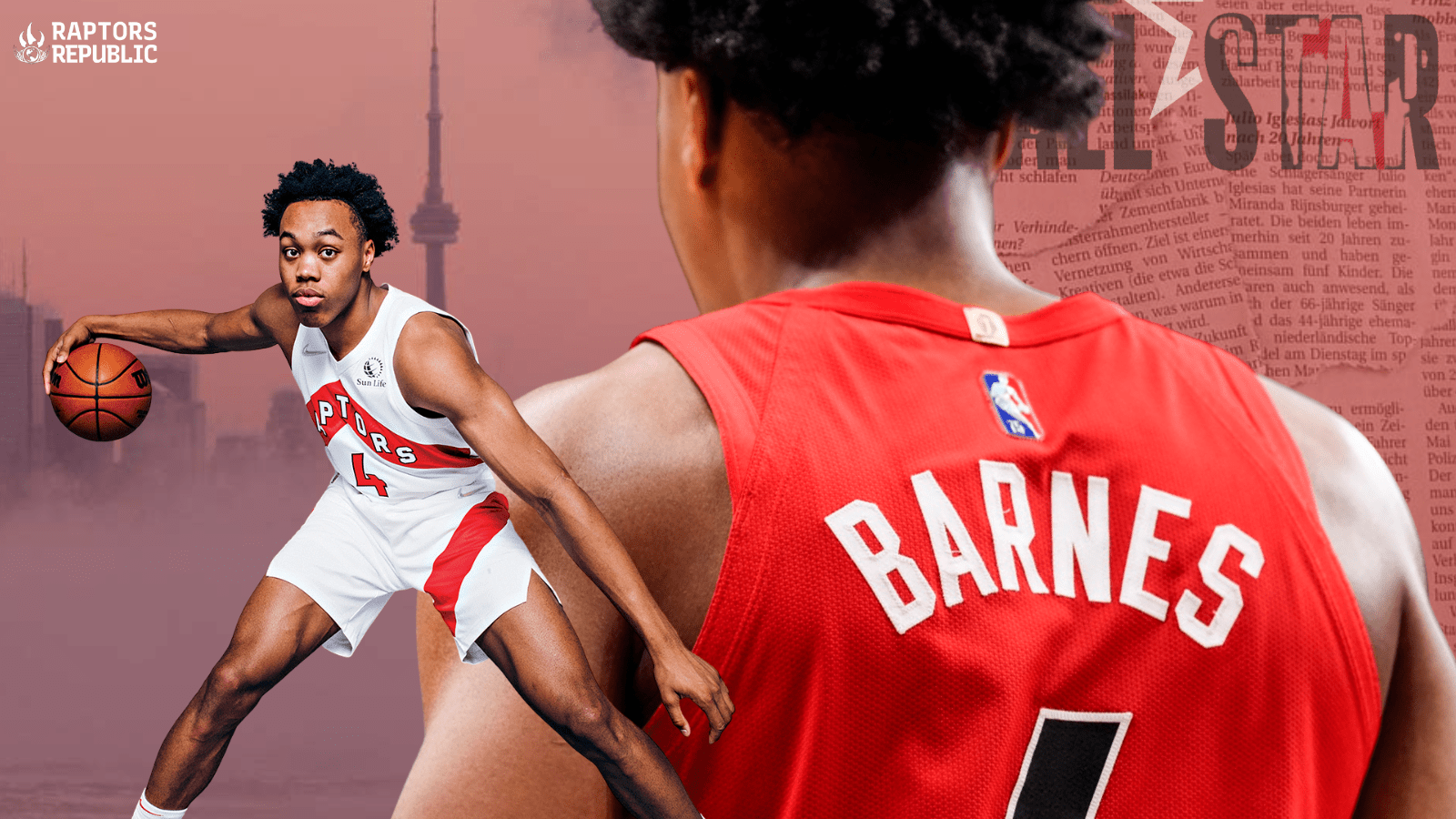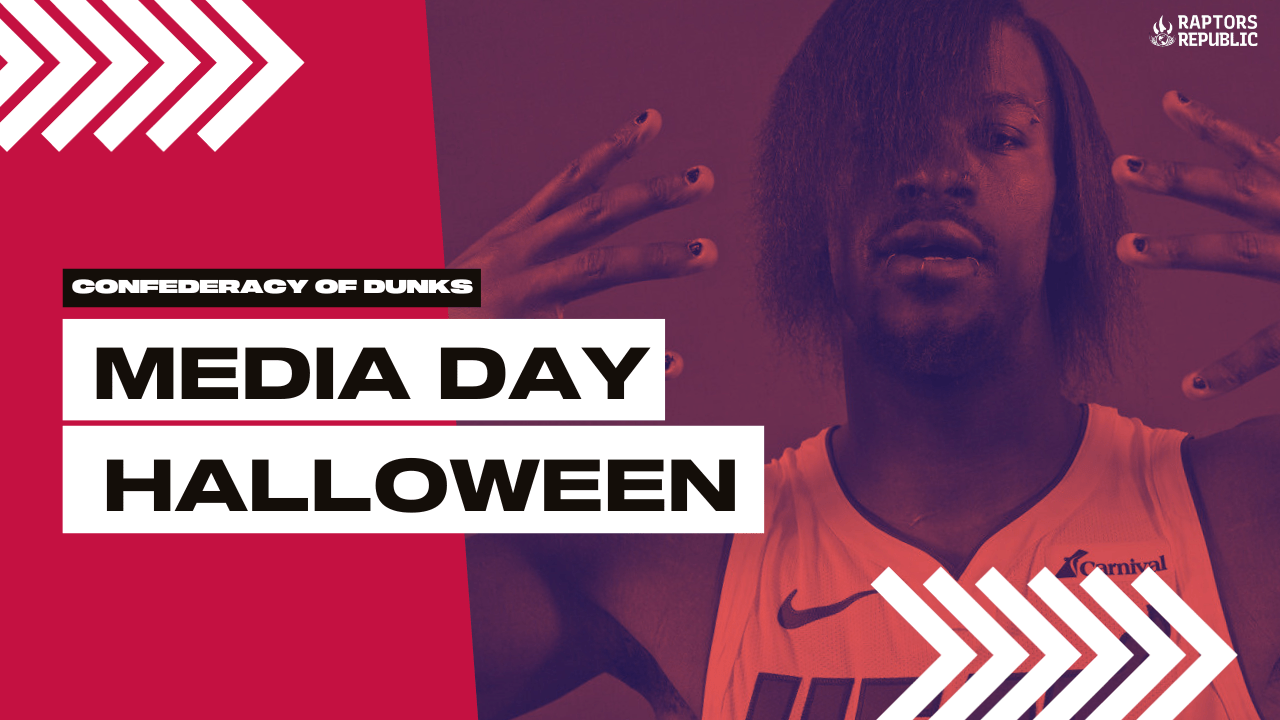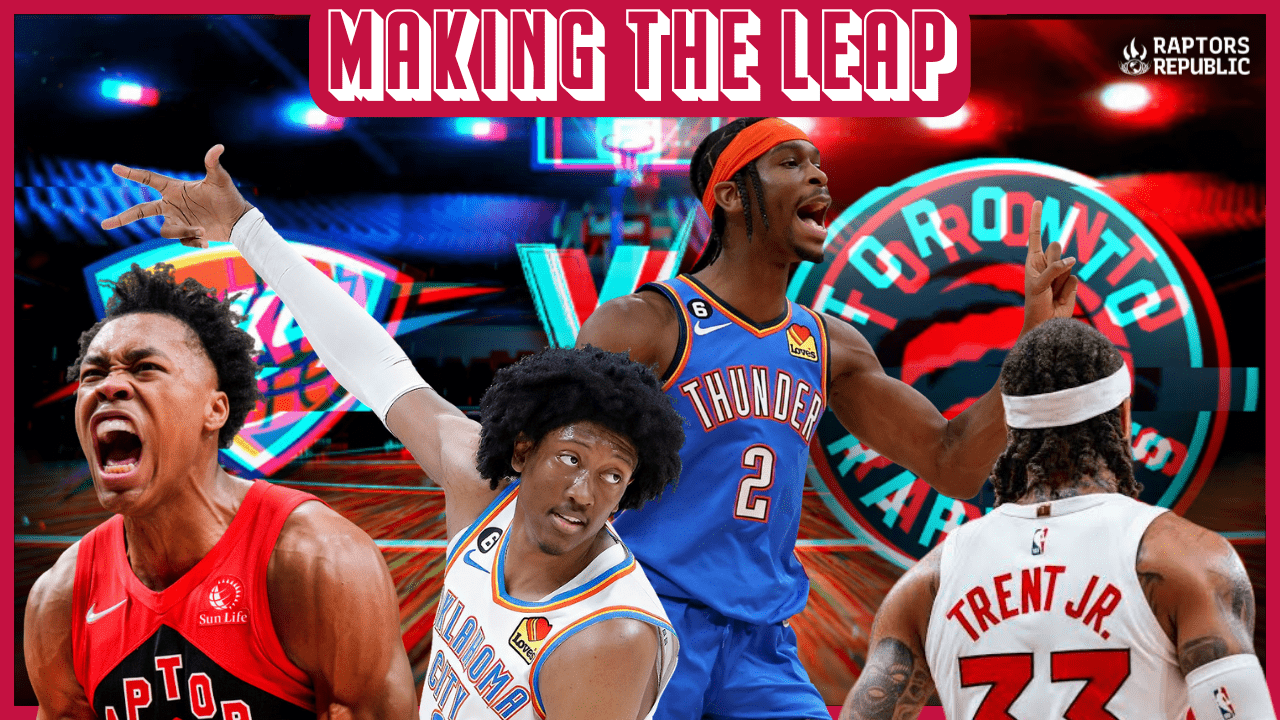So, I’ve rewatched every Scottie Barnes possession to look for what the statistics miss and to identify what might work in the future. This is the first of a three part series, all of which will be looking at how Barnes creates for himself and others. The Raptors are changing, and the overwhelming message behind the change: put the ball in Barnes’ hands. Point guard in the bio. I’ve talked to people within the organization who are skeptical, but Barnes, Masai Ujiri, and Darko Rajakovic have all voiced optimism for their big guard. Those are the opinions that matter most.
The most popular play in basketball? The pick n’ roll. Most often ran by guards, and most successfully ran by guards who meld elite pull-up shooting with an elite first step. Barnes is a very talented young player who can provide offensive punch in a multitude of ways, but more possessions means more pick n’ roll – where he’s struggled.
They have his points per possession on the advanced stats page — where Barnes was 18th percentile leaguewide, worse than everyone on the Raptors save for Dalano Banton and Will Barton — why watch every possession? Well, those stats only capture when Barnes scored or got fouled; and neither of those were the most common outcomes for a Barnes pick n’ roll possession. How often did Barnes create an advantage for a teammate? A gifted layup that didn’t drop? Did they set good screens for him? How was he most commonly defended? What off-ball actions did they run alongside his pick n’ rolls? All that and more is captured in this piece.
Let’s start with the obvious takeaways. Barnes doesn’t have a skillset that creates big advantages often in pick n’ roll actions. He’s not slim or sleek around screens, and teams don’t often give him an opportunity to turn the corner because they consistently go under on screens or switch. He doesn’t have the jumper to scare teams into chase, and he doesn’t have the handle to manipulate defenders back into re-screens (think of DeMar DeRozan). He’s a young player, who succeeds at a bunch of things that really good pick n’ roll players don’t, so his success in this play won’t ever define him as a player, but a lot of people say “Point Scottie”, and if that’s the case, there has to be more success here, especially if he’s going to continue being in the top half of the NBA in pick n’ roll frequency.
The good stuff, and quickly: Barnes is one of the best passers in the world, and when he has a live dribble any cut can be rewarded, and off-ball actions are more potent than usual. While he was 39th-percentile as a pick n’ roll ball handler last year, that was because of his struggles as a scorer. The pick n’ roll is for scoring first and foremost — Barnes’ points per chance were .759 as the shooter, 1.032 as the passer — and scorers bend defenses, creating gaps for teammates. However, Barnes is talented enough as a passer to need less bend from defenses to playmake.
“I think there are a lot of advantages there (with Scottie as point guard). First of all, he’s a willing passer. So, when you put him in pick n’ rolls he can see the court really well. We’ll try to move the court around pick n’ roll quite a bit, so, there are open passing lanes. I think he can be very good in pick n’ rolls when a small sets the screen, as well as a big – Jakob or Precious or any of our bigger players on the team can set screens for him. As far as his downhill attacks, there are a couple of things that he can definitely do better. We’ve been working on those during the summer and one of those is his left hand as well. He’s been doing a great job so far in the open gym, I’m really excited to see him on an NBA court in NBA games, to continue progressing his game.”
Darko Rajakovic
Barnes is also a young player who still has to figure out what makes his game tick. We see this with spurts of domination on offense. Those spurts don’t automatically come when he gets the ball — oftentimes when the Raptors gave him possessions, he was passive — but, rather when Barnes figures out how he’s going to attack in a given game. The hope is that as he grows he finds more and more counters and places of comfort to attack. In the pick and roll, as a scorer, he was by far the best when rejecting screens. It only happened 43 times last year, but Barnes was able to provide a hefty scoring punch (1.094 points per chance) when rejecting.
Players are eager to cheat to the push-switch or go under on Barnes, so naturally, as they’re evacuating a driving lane to occupy another? Go for it. Also, because most teams don’t care about playing chase/over on Barnes, instead opting for switches and unders? You can get the bigs up to the level of the screen. See what I’m getting at? An empty paint behind them, ripe for an aggressive drive. While navigating unders and switches is objectively harder, there are some unique wrinkles to that style of defense, and every style of defense has something that can be exploited. While it didn’t happen that often last year, Barnes will have opportunities for more of that this season.
“You just switch or you go under, either is fine. You don’t worry much. If he iso’s on the switch, hopefully it’s not a small on him. If it’s a wing or a big, he’s going to turn his back to the basket and bang around and that’s slow and you can track that. He can score like that, but it’s manageable. Off-ball, just make sure you don’t get back cut because he doesn’t miss those passes. For the most part though, we can just switch and he’ll reset the offense.”
NBA Team Scout on defending Barnes in the pick and roll
So, there’s 3 minutes of really, really great pick n’ roll passing reads being made in the video below. Feel free to go watch and then read the analysis, or toggle back and forth, or maybe you hate the writing and just appreciate the clipping – doesn’t matter, see you down below.
We see empty-side pick n’ roll, we see spread pick n’ roll, ghost screens, a couple disguised screens, drag screens in transition, step up screens, snug screens, even some spain (nice reverse dunk Chris). Barnes rejected screens, snaked to the middle, got some paint touches, threaded needles to rollers, tossed lobs, kept plays alive with his dribble, and in general made reads that very few players at his size make. That’s the appeal of putting the ball in his hands: mining basketball genius for all it’s worth.
You probably also saw missed passes and missed shots that would’ve otherwise been buckets. That lowers his playtype efficiency in a way he doesn’t deserve and makes the statistics look worse. However, the inverse is true as well – there’s tough shot-making that helps bump up the numbers, too. This is where my hand-tracked numbers always add way more value – I count advantages. If you can create advantages for yourself and teammates consistently? Eventually shot-making numbers will normalize and you’ll be in the green. If Scottie puts a layup in your lap and you blow it — click here for a video of advantages without buckets — the numbers say it’s a bad outcome, but my numbers say it’s good. If Scottie shovels you the ball on the perimeter and you make an 18-foot pullup? Numbers say it’s good, I say it’s bad. You get the point.
So, the numbers aren’t great. I tracked 514 pick and roll possessions with Barnes on ball and he created 114 advantages. Only 22-percent of the time. The lack of shooting, the lack of burst and handle? It created a lot of difficulties. The majority of plays didn’t amount to much, and if you’d like to watch a minute and a half of the unremarkable stuff click here. You can learn from the bad as well.
It didn’t help that the Raptors kept running double drags for him (more defenders involved, more clunk), but overall the Barnes pick and roll experiences were trite. Possessions that I didn’t count in the 514? When his pick and roll was a disguise for an off-ball action. This was the most successful thing the Raptors did during his pick and roll possessions, and something I’ve long wanted more of. If there’s off-ball actions with Barnes as the trigger man? You’re in a very good spot.
The Raptors had a pet lob play for Kyle Lowry & DeMar DeRozan that they ran for years and years, Rip Punch. For Scottie, a more sophisticated action with more moving parts, built off the same screen. Get ready for some coach terminology (when in doubt consult Evin Gualberto, superstar coach). Rip Veer STS (screen the screener) is first and foremost a lob play for O.G. Anunoby (or Boucher, but less so). The screen Scottie is coming off of is to occupy the help-side so the lob is open off of (usually VanVleet’s) the rip screen. If the lob isn’t available, Scottie’s screener sets a screen for VanVleet to come off for an open three. The quick way to communicate all that? Rip Veer STS – let me know if you recognize it in a game.
Why this works? Barnes is tall and can throw more aggressive lobs — Lowry’s height is why he was throwing the lobs 40 feet from the hoop and away from the defenders for Rip Punch, so he could put less arc on it and defenses couldn’t catch up — VanVleet has long been one of the best guard screeners in the league, the Raptors have a lot of guys who can finish a lob in a pinch, and even in a down year VanVleet’s gravity and shooting wasn’t much of a bad outcome – especially when Barnes puts it right in the shooting pocket. Maybe this play isn’t as valuable this year with a little less spacing, or maybe a guy like Gradey Dick becomes the rip screener, possibilities are abound. Also, just at the end of the video, you can see the Raptors run a little out of horns to enter a split-cut between Barnes & Siakam, and some high-low stuff. All good.
A quick play that encompasses the drawback and allure of Barnes on ball? He picks up the dribble too early, tries to make a lazy pass, gathers the ball and throws a dart of a no-look pass to Boucher for a lob that should’ve been converted.
And here, the pick n’ roll doesn’t net anything for the offense, but Barnes moves the ball along to set a screen, find a mismatch and draw a foul. So far in his career, Barnes has been better in the classical big man type plays, but he can try both on any given possession.
When I asked Darko about Barnes’ pick n’ roll usage, he did cite using small screeners first – which is meaningful. In the table below, you can see that Barnes had really successful partnerships with all 3 of Siakam, VanVleet, and Koloko – and struggled with Poeltl.

The VanVleet numbers only matter now to serve as a proxy for other Scottie + small screens, at this point. Despite VanVleet’s down season, he still had a lot of shooting gravity and planted really good screens as a guard. Schroder won’t emulate either of those aspects of VanVleet’s game easily, but he will be able to turn some of those catch-and-shoot opportunities into catch-and-go opportunities. Especially when you consider that most of the ghost screens are run toward an empty-side, there should be a lot of driving space in these actions, especially in transitional bench lineups with more shooting. We’ll see how that partnership grows, but above all else, Barnes can make the necessary reads as a passer and if teams switch the small on to him he can score in the mismatch.
What about Gary Trent Jr.? Only 23 screens all year (1.00 points per chance), so we are deeply entrenched in small-sample-size-theatre, but Trent Jr. is the Raptors best shooter, he can do it on the move, and the Raptors will have to go to it more often this season – even if it’s just to figure out how well it works.
The Siakam stuff isn’t particularly exciting, and rarely involves a lot going on. Two good players in a two-man action. A few times this season they managed to actually create a roll threat, but it’s mostly used to shed Siakam of the other teams best defender in a switch, and for him to feast on Barnes’ primary defender. The numbers are great, they can go to it in a jiffy, but it’s a slow approach on offense and other players involvement depends on if a double gets sent – which isn’t the best approach to lead with for a team that wants quicker offense that has more players involved. However, you can’t turn your nose up at results. We’ll see!
The news about Koloko’s respiratory problems is really sad to hear, and we all just have to hope that he and the training staff can get his body to where it needs to be soon. When he does come back though, he represents a high volume, successful screening partner for Barnes. The biggest motivator for success is obviously Koloko’s catch radius mixed with Barnes’ willingness to make aggressive passes in air space. There’s a lot of potential here, and it’ll be something to watch for when both players are healthy.
With Poeltl, the struggles are notable, and a direct result of Barnes’ difficulty navigating switches and unders – both of which are exacerbated by Poeltl’s complete lack of shooting. Poeltl being on the floor is an objective, overwhelming positive, but spacing makes offense a lot easier and the Raptors work out of a phone booth quite often. We will see more of this pairing though, and they have to find some counters. Rejects and snug pick n’ rolls were the best option that I saw, but you can’t always create the defensive response you want when looking for those outcomes.
Even if Barnes isn’t good in the pick n’ roll yet, it still behooves the Raptors to let him run it, and keep running it so that he can keep learning how defenses respond to him now, and as he elevates and grows his on-ball game.
As a teaser, here’s some isolations that came after teams switched the pick n’ roll. The second installment is Barnes’ creation out of isolations — I’ve also watched all of those — and we’ll get to dive deep on how Barnes bullies some of the biggest stars in the NBA with his brute physicality.
Hope you enjoyed learning about Scottie’s pick n’ roll prowess, how he’s been used, and how it might work in the future. He’s certainly not great at it yet, but there’s reasons to hope he can start to turn some weaknesses into strengths. Looking forward to how he works out of the pick n’ roll this year.
Have a blessed day.




